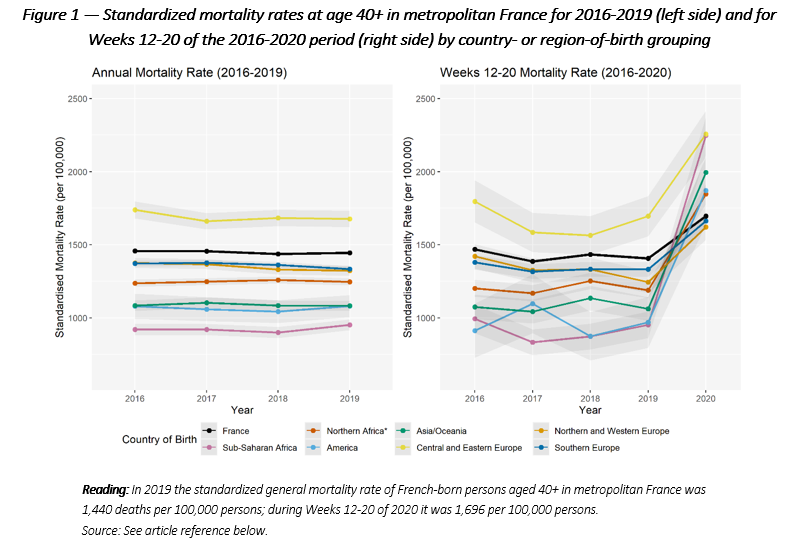Heavy excess mortality among immigrant groups in France during the first wave of the COVID-19 pandemic
Press release Published on 08 November 2022
In a study done by INED and INSERM in partnership with Santé Publique France and the Institut Convergences Migration, researchers[1] have shown that the excess mortality observed from March 18 to May 19, 2020, at the start of the COVID-19 pandemic, was much higher among France’s foreign-born population groups than in the French-born population. Their findings have been published in the journal Social Science and Medicine.
Excess mortality up to 9 times higher among immigrants than native-born
From 2016 to 2019, in the years preceding the COVID-19 pandemic, mortality rates in immigrant groups (with the exception of people from Eastern Europe) were lower than in the French-born population (see Figure 1). In normal circumstances this phenomenon is in fact observed across the world’s major immigrant-receiving countries.[2] But during the first wave of the epidemic in spring 2020, excess mortality among immigrant groups was much higher than among the French-born. The gap is visible at the age of 70 and over and is wider still among persons aged 40 to 69. For example, in that age bracket in the two regions hardest hit by the pandemic (Grand-Est and Ile-de-France), the excess mortality rate of immigrants from sub-Saharan Africa was 8 to 9 times higher than that of the French-born population while the rates of immigrants from North Africa, the Americas, and Asia/Oceania were 3 to 4 times higher.
Inequality in rising death rates early in the pandemic explains why overall mortality rates among immigrants born outside Europe—usually lower than for the French-born—were much higher during the first wave of the COVID-19 epidemic in France. The impact of that first wave thus caused an unprecedented shift in the usual mortality profile of these groups.
Multiple explanatory factors
During the first COVID-19 wave, the strict lockdown decreed by the French authorities worked to contain the pandemic’s impact on the healthcare system in terms of both hospitalization and mortality. However, that period also saw considerable differences in exposure to the virus by population group. In this context, the factors that explain the specific vulnerability of immigrant groups and the magnitude of the gaps in people over 70 are likely to be multiple and cumulative, and to implicate health inequalities due to
(1) the environment, living conditions (residential community density, household density) and working conditions (“indispensable” workers who cannot work remotely, the need to use public transport) that increase contamination risk;
(2) difficulty obtaining care, including hospital care, in a context of hospital facility saturation.
The findings of the study clarify the need for particular attention to living conditions, prevention, healthcare system access, and care availability for especially vulnerable groups in case of a new pandemic.
[1] Myriam KHLAT (INED), Walid GHOSN (INSERM), Michel GUILLOT (INED | University of Pennsylvania), Stéphanie VANDENTORREN (Santé Publique France), the DcCOVMIG Research Team
[2] The finding that mortality in many immigrant groups is lower than in native-born populations was unexpected given the fact that most immigrants are at an economic disadvantage. The main explanation put forward in the literature is that people who migrate are generally in better health than the population of their home country overall and often in better health than the population in the receiving country, at least when they arrive. This selection process is called the “healthy migrant effect.”

For more information, see
Myriam Khlat, Walid Ghosn (main co-authors), Michel Guillot, Stéphanie Vandentorren and the DcCOVMIG Research Team, 2022, "Impact of the COVID-19 crisis on the mortality profiles of the foreign-born in France during the first pandemic wave" Social Science and Medicine: 115160.
Article published in a scientific journal listed by evaluation authorities








